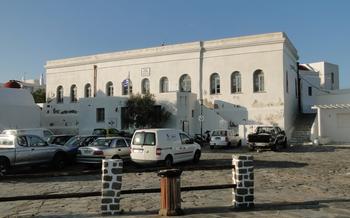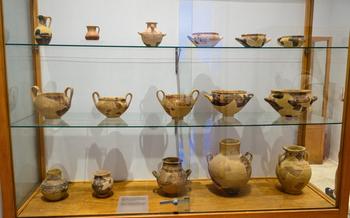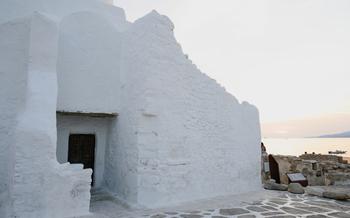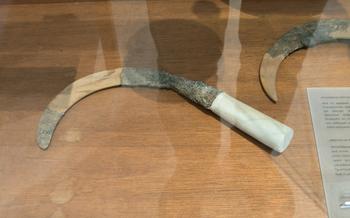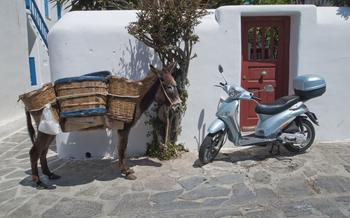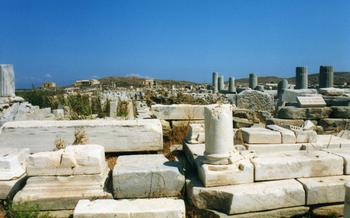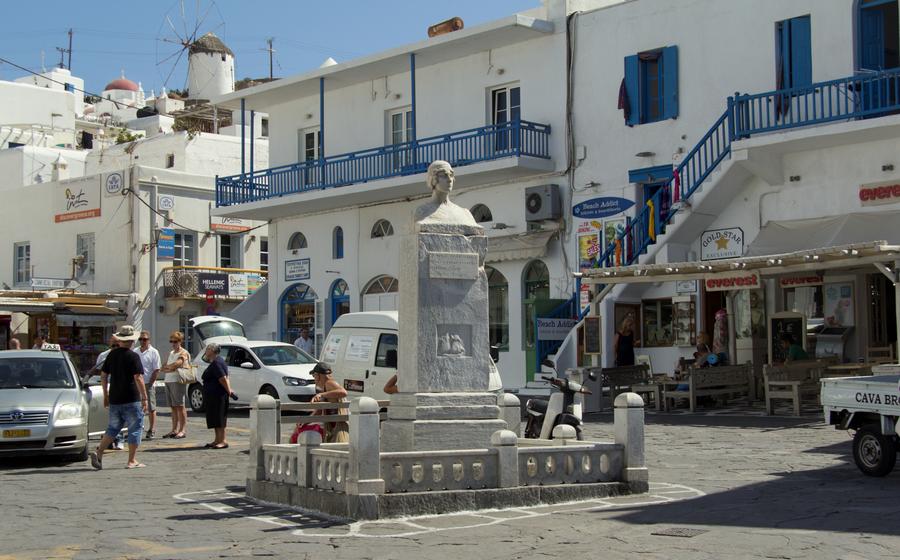
Manto Mavrogenous Square
- The Statue of Manto Mavrogenous: A Symbol of Strength and Resistance
- The Panagia Tourliani Church: A Sacred Sanctuary in the Heart of Mykonos
- The Municipal Library of Mykonos: A Treasure Trove of Knowledge and Culture
- The Archaeological Museum of Mykonos: A Journey Through the Island's Past
- The Folklore Museum of Mykonos: Preserving the Island's Traditions
- The Mykonos Windmills: Embracing the Island's Nautical Heritage
- Little Venice: A Picturesque Waterfront District in Mykonos
- Matoyianni Street: The Heart of Mykonos Town
- The Old Port of Mykonos: A Gateway to the Island's Natural Beauty
- Super Paradise Beach: A Tranquil Oasis for Relaxation and Sunbathing
- Agrari Beach: A Secluded Gem for Nature Lovers and Water Sports Enthusiasts
- Elia Beach: The Longest and Most Family-Friendly Beach in Mykonos
- Insider Tip: Explore Mykonos Beyond the Beaches
The Statue of Manto Mavrogenous: A Symbol of Strength and Resistance
Manto Mavrogenous was a remarkable woman who played a significant role in the Greek War of Independence. As a wealthy and educated woman, she defied societal expectations and dedicated her life to fighting for her country's freedom. She used her own fortune to fund the Greek army, organized and led troops into battle, and even fought alongside the men on the front lines. Her bravery and determination earned her the title of "Heroine of the Greek Revolution."
In recognition of her contributions, a statue of Manto Mavrogenous stands proudly in the square that bears her name. Created by the renowned sculptor Nikiforos Lytras, the statue captures the essence of her strength and resilience. Manto is depicted in a dynamic pose, her head held high and her gaze fixed on the horizon, as if she is ready to face any challenge that comes her way. The statue serves as a powerful symbol of female empowerment and a reminder of the important role women played in the Greek struggle for independence.
An interesting fact about the statue is that it underwent a major restoration in 201Over time, the bronze had become weathered and worn, and the statue was in need of some TLC. A team of skilled conservators carefully cleaned and repaired the statue, ensuring that it would continue to stand as a proud symbol of Manto Mavrogenous and her legacy for generations to come.
The Panagia Tourliani Church: A Sacred Sanctuary in the Heart of Mykonos
Standing tall in the heart of Mykonos Town, the Panagia Tourliani Church is a testament to the deep religious roots of the island. Dating back to the 18th century, this magnificent edifice seamlessly blends Byzantine and Cycladic architectural styles, creating a unique and awe-inspiring spectacle. Intricate carvings adorn its whitewashed exterior, while inside, the church's interior is adorned with stunning frescoes and iconography, narrating the stories of saints and biblical events.
As a place of worship and pilgrimage, Panagia Tourliani holds immense religious significance for the people of Mykonos. Devotees from all corners of the island flock to the church to seek solace, offer prayers, and celebrate religious festivals. During my visit, I had the privilege of attending a traditional Greek Orthodox service in the church, an experience that left me deeply moved and inspired. The melodious chanting of the choir, the rhythmic swaying of incense, and the palpable devotion of the congregation created an atmosphere of profound spirituality that transported me to another realm.
Beyond its religious significance, Panagia Tourliani is also a cultural landmark of Mykonos. It serves as a repository of the island's rich history and traditions, hosting exhibitions and events that showcase Mykonian culture and heritage. Whether you're a devout pilgrim or simply a curious traveler, a visit to this sacred sanctuary is an absolute must, offering a glimpse into the spiritual and cultural essence of Mykonos.
The Municipal Library of Mykonos: A Treasure Trove of Knowledge and Culture
Established in 1959, the Municipal Library of Mykonos stands as a testament to the island's rich cultural heritage. Its collection boasts a wealth of rare books, manuscripts, and local history archives, making it a treasure trove for scholars, researchers, and history enthusiasts alike. As you step into the library's serene reading room, you'll be greeted by a sense of awe and wonder, surrounded by shelves upon shelves of literary treasures.
Among the highlights of the collection are rare editions of Greek classics, manuscripts dating back to the Byzantine era, and a comprehensive archive of local newspapers and documents. The library also houses a significant collection of books on Mykonian history, culture, and folklore, providing valuable insights into the island's unique identity and traditions.
Beyond its collection, the Municipal Library of Mykonos serves as a vibrant center for research and education. It regularly hosts lectures, workshops, and literary events, bringing together scholars, authors, and the local community to engage in intellectual discourse and cultural exchange. Whether you're seeking knowledge, inspiration, or a quiet space to delve into a good book, the Municipal Library of Mykonos is a must-visit destination for anyone interested in the island's cultural heritage.
Insider Tip: To make the most of your visit, check the library's calendar for upcoming events and workshops. Attending a literary event or discussion is a fantastic way to connect with local authors, learn about Mykonian culture, and gain a deeper appreciation for the island's rich literary traditions.
The Archaeological Museum of Mykonos: A Journey Through the Island's Past
The Archaeological Museum of Mykonos is a treasure trove of artifacts that narrate the captivating story of the island's rich history. Housed in a beautiful neoclassical building in Mykonos Town, the museum takes visitors on a journey through time, showcasing a diverse collection of ancient pottery, sculptures, jewelry, and tools that provide a glimpse into the island's past.
One of the highlights of the collection is a stunning marble statue of a kouros, a young man, dating back to the 6th century BC. The statue, with its serene expression and intricate details, is a testament to the artistic prowess of ancient Greek sculptors. Another highlight is a collection of pottery from the Geometric period (900-700 BC), featuring distinctive geometric patterns and motifs that offer insights into the artistic traditions of the time.
The museum also houses a fascinating collection of artifacts from the Hellenistic period (323-146 BC), including bronze figurines, coins, and jewelry. These artifacts provide valuable clues about the island's role in trade and cultural exchange during that era. The museum's collection is not just limited to ancient artifacts; it also includes finds from the Byzantine and Venetian periods, showcasing the island's diverse cultural heritage.
A visit to the Archaeological Museum of Mykonos is not just an educational experience but also an opportunity to connect with the island's rich past. The museum's well-curated exhibits, informative panels, and knowledgeable staff make it an ideal place to learn about Mykonos' fascinating history and gain a deeper appreciation for its cultural heritage.
The Folklore Museum of Mykonos: Preserving the Island's Traditions
Nestled in the heart of Mykonos Town, the Folklore Museum stands as a testament to the island's rich cultural heritage. Established in 1958, the museum is dedicated to preserving and showcasing the traditional way of life that has shaped Mykonos over the centuries.
Inside the museum's charming whitewashed walls, visitors are transported back in time through a collection of artifacts and exhibits that depict various aspects of Mykonian culture. Traditional costumes, intricately embroidered with colorful threads, hang on display, capturing the essence of the island's vibrant attire. Household items, such as woven baskets, ceramic pots, and copperware, provide a glimpse into the daily lives of the island's inhabitants.
Agricultural tools, once used to till the land and harvest the fruits of the earth, stand as reminders of Mykonos' strong connection to farming and agriculture. Through these artifacts, the museum tells the story of a community deeply rooted in its traditions and the resilience of its people in preserving their heritage.
A visit to the Folklore Museum of Mykonos is not just a journey through history but also an opportunity to appreciate the enduring spirit of the island. It is a reminder that amidst the cosmopolitan allure of modern Mykonos, the essence of its past remains alive, waiting to be discovered by those who seek a deeper connection with its cultural roots.
Insider Tip:
Plan your visit to coincide with one of Mykonos' traditional festivals to witness the island's folklore come to life. During these vibrant celebrations, the streets are filled with music, dance, and the infectious energy of the local community. Immerse yourself in the festivities, indulge in the local cuisine, and experience the authentic spirit of Mykonos firsthand.
The Mykonos Windmills: Embracing the Island's Nautical Heritage
Mykonos is synonymous with its iconic windmills, which have become a symbol of the island's rich maritime history. These majestic structures, once used for grinding wheat and producing flour, now stand as silent sentinels, evoking a sense of nostalgia and romance.
The windmills of Mykonos date back to the 16th century when the island was a major trading hub in the Aegean Sea. The Venetian rulers of the island introduced the technology of windmills, which quickly became an essential part of Mykonos' economy. The windmills were strategically positioned on the highest points of the island, capturing the strong winds that swept across the Aegean.
Architecturally, the windmills of Mykonos are a blend of traditional Greek and Venetian styles. Their cylindrical stone towers, topped with conical roofs, are reminiscent of medieval fortresses. The windmills are typically painted in bright white, reflecting the island's signature color scheme.
Beyond their practical function, the windmills of Mykonos hold a deep symbolic meaning. They represent the island's resilience and its ability to adapt to changing times. The windmills have withstood the test of time, serving as a reminder of Mykonos' enduring spirit.
Interestingly, some of the windmills have been transformed into museums and art galleries, offering visitors a glimpse into the island's history and culture. These restored windmills have become popular tourist attractions, allowing visitors to experience the magic of these iconic structures firsthand.
Little Venice: A Picturesque Waterfront District in Mykonos
Nestled along the enchanting waterfront of Mykonos Town, Little Venice, also known as the Little Venice of Mykonos, is an iconic neighborhood that blends history, charm, and breathtaking beauty. Step into this picturesque district, and you will be greeted by a maze of narrow, cobbled streets lined with colorful houses and balconies that seem to float above the crystal-clear waters of the Aegean Sea.
This vibrant neighborhood has a rich history dating back to the 18th century when wealthy sea captains and merchants built their homes along the waterfront. Its unique architectural style, influenced by both Greek and Venetian traditions, is characterized by brightly painted houses with wooden balconies, arched doorways, and wrought-iron railings. The colorful facades, adorned with flowers and bougainvillea, create a picture-perfect setting that will leave you in awe.
Little Venice is not just a feast for the eyes but also a vibrant hub for dining, shopping, and nightlife. Wander through the charming streets and discover an array of boutiques, art galleries, and souvenir shops, each offering a unique selection of treasures. As the sun sets, the district transforms into a lively nightlife destination, with bars and restaurants spilling out onto the waterfront, inviting you to enjoy a cocktail or a delicious meal while basking in the magical ambiance.
To fully experience the charm of Little Venice, take a leisurely stroll along the waterfront promenade, soak in the stunning views of the harbor, and watch the traditional fishing boats bobbing gently on the waves. Capture the essence of this picturesque neighborhood with your camera and create lasting memories of your time in Mykonos. Whether you seek tranquility or vibrant energy, Little Venice has something to offer every traveler who sets foot on its enchanting shores.
Matoyianni Street: The Heart of Mykonos Town
In the heart of Mykonos Town, a vibrant artery pulsates with life, a whirlwind of energy that draws travelers from far and wide. Matoyianni Street, named after a local hero of the Greek War of Independence, is an epicenter of activity, where the essence of Mykonos unfolds in all its glory.
Strolling along this bustling promenade, visitors are greeted by a kaleidoscope of shops, boutiques, and restaurants, each vying for attention with their unique offerings. The air is alive with a symphony of sounds, from the cheerful chatter of locals to the infectious laughter of tourists relishing the moment.
Matoyianni Street is a place to see and be seen, where the fashion-forward flaunt their latest finds, and celebrities mingle with the throngs of visitors. As the sun begins its descent, the street transforms into a vibrant hub of nightlife, with bars and clubs spilling onto the cobblestone streets, their music reverberating through the air.
Beyond its reputation as a shopping and entertainment haven, Matoyianni Street holds cultural significance as a meeting point, a place where locals and tourists converge to exchange stories, share laughter, and soak up the infectious energy of Mykonos.
Insider tip: To fully experience the magic of Matoyianni Street, visit during the summer months when the street truly comes alive with outdoor events, live music, and a palpable sense of celebration.
The Old Port of Mykonos: A Gateway to the Island's Natural Beauty
The Old Port of Mykonos, with its picturesque harbor and iconic whitewashed houses, serves as a gateway to the island's natural beauty. Once a bustling hub for trade and transportation, the port has transformed into a charming destination for locals and tourists alike.
Strolling along the waterfront promenade, visitors can soak in the stunning views of the harbor, with its colorful fishing boats and yachts bobbing gently on the turquoise waters. The surrounding whitewashed houses, with their blue-painted doors and windows, add to the port's picturesque charm.
The Old Port is not just a place to admire the scenery but also a vibrant meeting point for locals and tourists. Cafés and tavernas line the waterfront, offering a delightful selection of fresh seafood, traditional Greek dishes, and refreshing drinks. Visitors can relax and savor the flavors of Mykonos while enjoying the lively atmosphere of the port.
For those seeking adventure, the Old Port serves as a gateway to explore the island's natural wonders. Boat tours depart regularly from the harbor, taking visitors to nearby islands like Delos, a UNESCO World Heritage Site renowned for its ancient ruins. Water sports enthusiasts can indulge in activities such as jet skiing, parasailing, and scuba diving, immersing themselves in the crystal-clear waters of the Aegean Sea.
As the sun begins to set, the Old Port transforms into a magical place. The sky explodes into vibrant hues of orange, pink, and purple, casting a warm glow over the harbor. Visitors can take a leisurely stroll along the promenade, enjoying the breathtaking views and the gentle sea breeze.
The Old Port of Mykonos is a place where history, culture, and natural beauty converge. Whether you seek relaxation, adventure, or a taste of authentic Greek life, the Old Port has something to offer everyone.
Super Paradise Beach: A Tranquil Oasis for Relaxation and Sunbathing
Super Paradise Beach stands as a stark contrast to its neighboring party hotspot, Paradise Beach. Here, tranquility reigns supreme, inviting visitors to immerse themselves in the island's natural beauty. The beach boasts stunning views of turquoise waters that blend seamlessly with golden sands, framed by majestic rocky cliffs. As you step onto this secluded paradise, the stresses of modern life melt away, replaced by a sense of serenity and peace.
Super Paradise Beach's allure lies in its ability to transport visitors to a realm of tranquility. The atmosphere is relaxed and laid-back, with a handful of tavernas and beach bars dotting the landscape, offering refreshments and snacks to those seeking sustenance without sacrificing the tranquil ambiance.
Beyond its visual splendor, Super Paradise Beach holds cultural significance as a sanctuary for those seeking respite from the bustling crowds that frequent other parts of Mykonos. It represents a place where individuals can reconnect with nature, embrace the simplicity of life, and bask in the tranquility of their surroundings.
Practical Information:
-
Getting to the Beach: Super Paradise Beach is accessible by water taxi from Mykonos Town or by car or motorbike along a scenic coastal road.
-
Beach Facilities: The beach offers a range of amenities, including sunbeds, umbrellas, and water sports facilities for those seeking a more active experience.
-
Tips for Finding a Secluded Spot: To escape the crowds and find a secluded spot to soak in the tranquility, venture further along the beach, away from the main entrance.
Agrari Beach: A Secluded Gem for Nature Lovers and Water Sports Enthusiasts
Agrari Beach is a hidden gem located on the southern coast of Mykonos, offering a tranquil escape from the bustling crowds of the more popular beaches. With its unspoiled natural beauty, crystal-clear waters, and stunning views of the surrounding landscape, Agrari is a paradise for nature lovers and water sports enthusiasts.
The beach is characterized by its secluded location, surrounded by rocky cliffs and lush vegetation. This creates a sense of privacy and exclusivity, making it the perfect place to relax and unwind away from the hustle and bustle of the main tourist areas.
Despite its secluded location, Agrari Beach offers a range of amenities to ensure a comfortable and enjoyable experience. There are a few tavernas and beach bars offering refreshments, snacks, and sunbeds for rent. For those looking for a more active experience, there are water sports facilities available, including snorkeling, diving, and paddleboarding.
The crystal-clear waters of Agrari Beach are ideal for swimming, snorkeling, and diving. The underwater world is rich in marine life, with a variety of colorful fish and coral formations to explore. The beach is also a popular spot for windsurfing and kitesurfing, thanks to the strong winds that often blow in the area.
Overall, Agrari Beach is a secluded paradise that offers a perfect blend of natural beauty, tranquility, and water sports activities. Whether you're looking to relax on the beach, explore the underwater world, or enjoy some adrenaline-pumping water sports, Agrari Beach has something to offer everyone.
Elia Beach: The Longest and Most Family-Friendly Beach in Mykonos
Elia Beach stands out as the longest and most family-friendly beach on the island of Mykonos. Its sprawling stretch of golden sand, shallow waters, and gentle waves create a safe and inviting environment for families with young children. Sunbeds, umbrellas, and water sports facilities, including pedal boats and kayaks, are available for rent, ensuring a comfortable and enjoyable beach experience.
Beyond its family-friendly amenities, Elia Beach holds cultural significance as a place where locals and tourists alike gather to relax and unwind. The beach's laid-back atmosphere and stunning views of the Aegean Sea make it an ideal destination for those seeking a respite from the bustling crowds of Mykonos Town.
Practical Information:
-
Getting to Elia Beach: Elia Beach is located on the southern coast of Mykonos, approximately 10 kilometers from Mykonos Town. It is accessible by car or bus, with ample parking available near the beach.
-
Beach Facilities: Elia Beach offers a range of facilities, including sunbeds, umbrellas, showers, changing rooms, and a lifeguard station. Several tavernas and beach bars line the shore, providing refreshments, snacks, and light meals.
-
Tips for Finding a Shady Spot: To avoid the midday sun, arrive early in the morning or late in the afternoon to secure a spot under one of the natural tamarisk trees that dot the beach. Alternatively, rent an umbrella from one of the beach vendors.
Insider Tip: Explore Mykonos Beyond the Beaches
While Mykonos is renowned for its stunning beaches, the island offers a wealth of hidden gems and cultural experiences beyond the shoreline. Immerse yourself in the authentic side of Mykonos by exploring its charming villages, each with its unique character and traditions. Ano Mera, with its picturesque whitewashed houses and the 16th-century Panagia Tourliani Monastery, offers a glimpse into the island's rich history and religious heritage.
Venture off the beaten path and discover the traditional festivals and events that celebrate Mykonos' vibrant culture. Attend a lively panigiri (village feast) to experience the infectious energy of traditional Greek music, dancing, and local delicacies. Don't miss the opportunity to savor the island's renowned cuisine, known for its fresh seafood, locally sourced ingredients, and mouthwatering dishes like moussaka and pastitsio.
For a deeper dive into Mykonos' culinary heritage, take a cooking class and learn to prepare traditional Greek dishes using fresh, local ingredients. Discover the secrets of making the perfect dolmades (stuffed vine leaves) or gemista (stuffed tomatoes and peppers).
Mykonos also offers a variety of day trips to nearby islands, each with its unique charm. Delos, a UNESCO World Heritage Site, is a must-visit for history buffs, boasting ancient ruins and artifacts that tell the story of the island's mythological and historical significance. Rhenia, with its pristine beaches and crystal-clear waters, provides a tranquil escape from the crowds.
Unleash your adventurous spirit and explore Mykonos' hidden coves and secluded beaches, accessible only by foot or boat. Discover secret swimming spots, dive into the crystal-clear waters, and bask in the tranquility of unspoiled natural beauty.
My personal anecdote: Venturing beyond the beaches of Mykonos led me to discover the island's hidden gem, the charming village of Ano Mera. Strolling through its narrow cobblestone streets, I stumbled upon a traditional bakery, where the aroma of freshly baked bread filled the air. I indulged in a delicious bougatsa, a flaky pastry filled with sweet custard, and savored the authentic taste of Mykonos.

